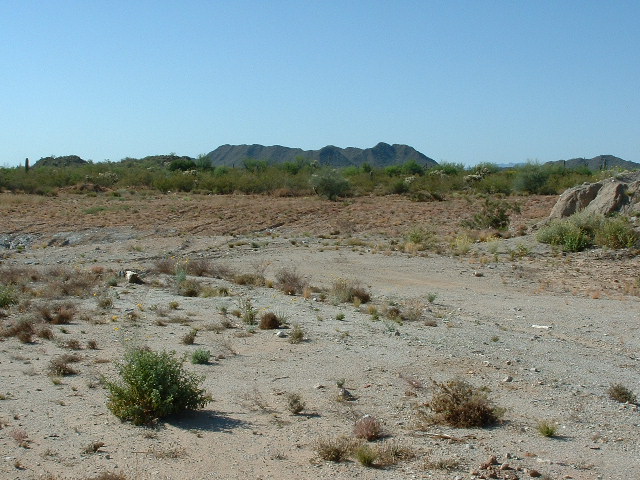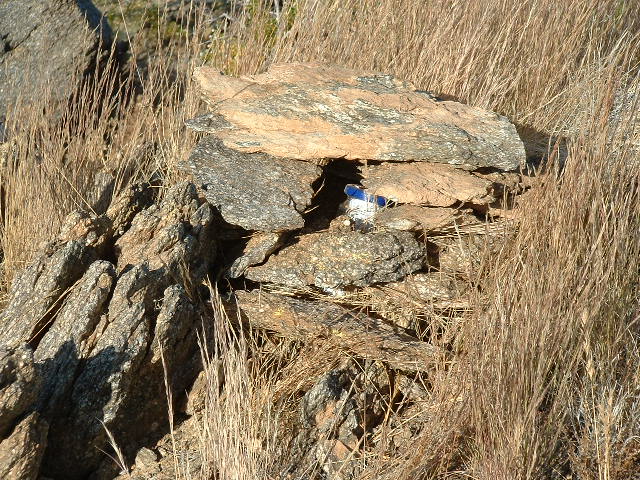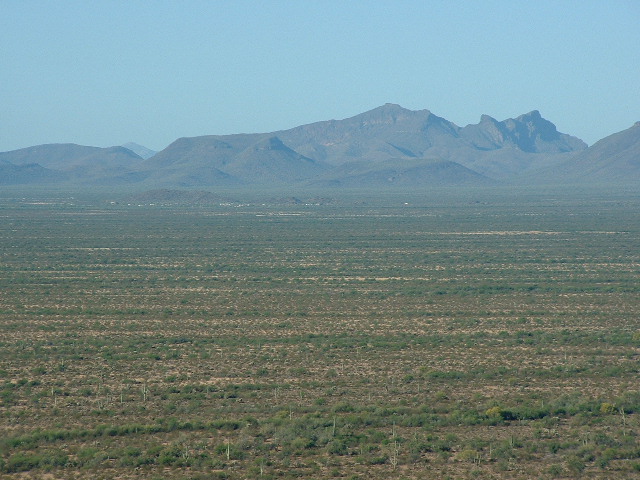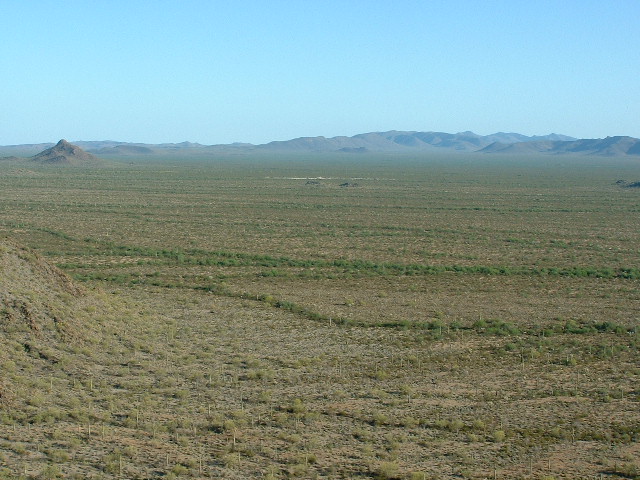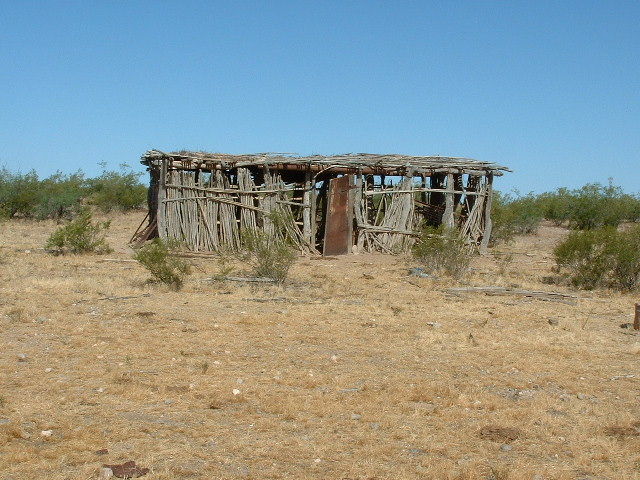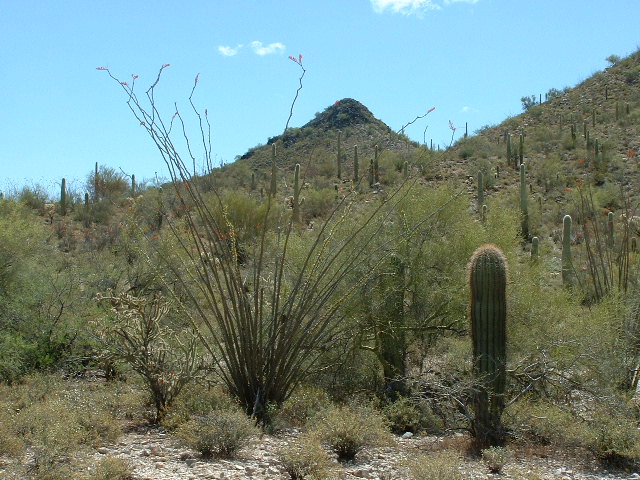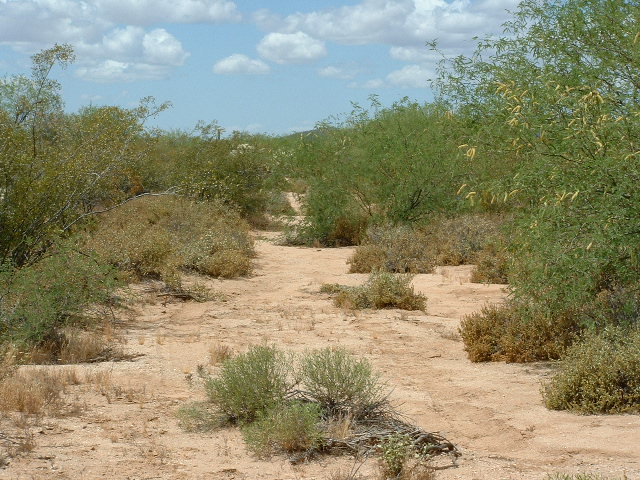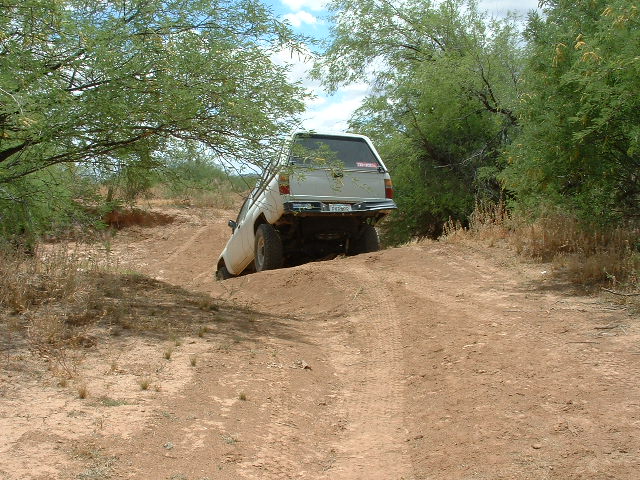They were predicting a high temperature of 74 degrees for Monday, April 25, 2005 here in the desert. That is about 10 degrees cooler than normal, so I felt I couldn’t pass up such an opportunity – I had to go climbing.
I left my house at 3:15 am and headed west. By 5:15 am I was parked at the Little Chief mine on the far western side of the reservation. This is an open-pit mine which is abandoned, for how long I don’t know. It did make a good place to park, almost a mile south of the paved highway and probably visited by nobody these days. The sun hadn’t yet risen but it was broad daylight. I shouldered my pack and headed south across the desert. I was here to climb Peak 2505, the only one I had not yet climbed in the Gunsight Hills.
I soon came to a barbed-wire fence. Simple enough – I just crawled under it and continued. I found a discarded backpack and a few empty water jugs en route. I even crossed traces of a couple of old roads trending east-west. These are not shown on any of my maps, and I couldn’t really get a sense of where they were going. Certainly not in my direction.
When I was maybe 1 1/2 miles away from my truck, I heard a noise in the distance – it was a motor of some kind. I finally concluded that it was a helicopter. I looked back the way I had come and spotted a large chopper hovering near where I had parked my truck. It wasn’t a Blackhawk – rather, it was a whitish color and smaller, but still a pretty big machine. It had to have been the Border Patrol. There was nothing I could do about it, being so far away. I had posted my permit clearly inside the vehicle on the driver’s window. They spent an inordinately long time flying around the truck. I suspect they may have landed and checked it out, as there was plenty of room to do so where I was parked at the open-pit mine. After a while, they slowly flew away. When I got back to the truck later on, I noticed it was covered in dust, a sure sign they had flown near it. All the drama with the chopper lasted about 10 minutes – I just kept walking. Finally, I reached the base of Peak 2505.
I had made a guess as to which of the many bumps along the ridge would be the high point, so I climbed up the north side directly to my objective. I had guessed correctly. Using my 5-power hand level, I could plainly see that Point 2498 to the west was lower than my position. The 7 1/2′ quad that covers this area has ten-foot contours. There is another point 650 feet to the southeast which on the map looks almost as high, but is shown with one less contour. The hand level proved that it too was lower. There was no sign of any previous visit. I took a register out of my pack, entered my info, and put it inside a cairn I built. The next photo shows the register I placed on top of Peak 2505. I left the glass jar exposed for illustration, but I would cover it up better than that, as a rule. You don’t want to spend a long time building a cairn, but do need enough rocks to protect the register and to make an obvious pile so that future climbers can spot it easily. You usually try to put it on the very highest point, as that is where climbers will first look for a register.
There were great views across wide swaths of desert in every direction. I noticed what appeared to be a fence-line with perhaps an old road alongside of it, running NE to SW, very near to the eastern base of my mountain. Perhaps this could be used as access. It looks as if it might originate from the area of the village of San Simón. The next photo shows a long view from Peak 2505 across the desert to the southwest. You are looking over the village of Gu Vo to the Ajo Range 16.4 miles distant. The prominent peaks to the right of center are Diaz Peak and Diaz Spire.
From the summit, I could see back to where I had started. This picture shows a tiny white smudge just above center – that’s the mine where I was parked. Ninemile Peak is seen on the left edge of the photo.
I descended and walked back across the desert to my truck. It had been a 6-mile round trip and had taken less than 3 hours. I was now done with the Gunsight Hills. I drove back out to AZ Highway 86, and then west for about two miles, where I turned north off the highway just west of Ninemile Peak. There was an unlocked wire gate, and, once through it, I headed northeast for several miles along a seldom-used dirt road. More border-crossers on foot than vehicles had used this road in recent times, as evidenced by discarded clothing, backpacks and other paraphernalia en route. I arrived at an old house by a corral – this used to be somebody’s home. It had old bedsprings inside and not much else. The sticks making up the walls are ocotillo ribs. The roof is made of sticks and covered with dirt.
Beyond the house, the road got pretty rough near a tank. Very high clearance needed. I was looking for an east-west road to cross my path, but didn’t see it. It turns out that it had so badly deteriorated that I couldn’t spot it the first time I went past.
I was here to climb a group of three peaks which are separated from the south end of the Gakolik Mountains by a mere 1,700 feet of desert floor. Are they a part of the Gakoliks? Maybe. But the labeling on the topo maps doesn’t continue on to this group of three, so probably not. The Gakolik Mountains are comprised of one ridge, four miles long, with one summit. Might as well call it Redondo Peak (after the name of the benchmark on the high point) rather than the Gakolik Mountains. Anyway, to my surprise and delight, the old road I was on continued north. It is shown on the old 1:100,000-scale maps, but not at all on the newer 1:24,000-scale maps. It was easy to follow, and so I used it to get right up beside Peak 2567.
When I can park so close to a peak, I will often not take a pack to the top. Instead, I put a register in my pocket (albeit a small one) and whatever else I may need. Takes me back to earlier days climbing in British Columbia with my old Canadian climbing partner Brian Rundle. We did plenty of “anorak climbs” in those days. An anorak is a heavy jacket with a hood attached. In our case, it was usually foul-weather gear. We would stuff our pockets full of food, water, map, compass and whatever else we needed for the summit bid and leave the pack behind. Nowadays, my small day pack usually weighs 15 to 20 pounds with all the crap I carry, a lot of it being the bottles of gatorade and other drinking materials, so I’ll gladly leave it behind every chance I get. I did Peak 2567 this way.
I called Dottie from the top, then left a cairn and register, and did the same on Peak 2557 farther south. I then drove back south, this time finding the east-west road. It was badly overgrown and appeared to not have been used for years.
I followed it eastwards for about half a mile and parked. I was at the base of a small hill called Kavolik. It took only 15 minutes to climb it, place a register and return to the truck. My climbing done for the day, I started the drive back out and came to a steep-sided wash. It can be a gamble driving through one of these, especially if you are a convoy of one. If you get stuck, you may not be able to extricate yourself without help. Nobody is going to come driving by. You would have to walk out to a road where there is a chance of flagging down a vehicle. No tow truck is going to come in to pull you out. Your only chance of getting your vehicle back would be to convince some friend with a four-wheel-drive to take you back in and help get your vehicle unstuck. It is much smarter to do this with at least two vehicles. Even more so since my vehicle had 275,000 miles on it.
Once done with the wash, I drove back out to the highway and then home. There may not be any more days as pleasant as this one, temperature-wise, until the fall. I’m just glad I could get out and enjoy it.
Please check out our Facebook page at https://www.facebook.com/pages/Desert-Mountaineer/192730747542690

